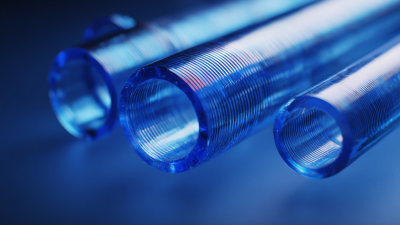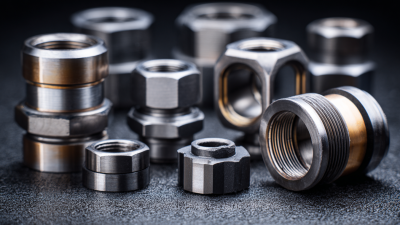5 Essential Tips for Choosing Quick And Easy Fittings for Your Projects
In today's fast-paced construction and DIY industries, the demand for efficiency and simplicity has led to the growing popularity of Quick And Easy Fittings. According to a recent industry report by IBISWorld, the plumbing and fittings market is projected to reach over $75 billion by 2025, driven by innovations in product design that prioritize user-friendliness and ease of installation. This shift underscores the importance of selecting fittings that not only streamline project execution but also enhance overall productivity. In light of these trends, understanding the key strategies for choosing the right Quick And Easy Fittings can significantly impact project outcomes, reduce labor costs, and help ensure high-quality results. In this blog, we will explore five essential tips that empower homeowners, contractors, and DIY enthusiasts to make informed decisions in selecting the best fittings for their unique projects.

Understanding Different Types of Quick and Easy Fittings Available in the Market
When it comes to selecting quick and easy fittings for your projects, understanding the various types available on the market is crucial. From pneumatic quick disconnect fittings to different types of solar connectors, the right choice can significantly impact the efficiency and effectiveness of your work. As the demand for reliable and versatile fittings continues to grow, it’s essential to familiarize yourself with the options and their specific functionalities.
One tip when choosing fittings is to consider the application they will be used for. For instance, pneumatic fittings are ideal for air-powered tools and machinery, while solar connectors are essential for solar panels and systems. Make sure to assess the compatibility of the fittings with your existing components to ensure optimal performance.
Another key consideration is the quality of materials and construction of the fittings. High-quality fittings not only provide durability but also enhance safety in various applications. Look for products that can withstand environmental challenges, ensuring a long-lasting solution for your projects. Taking the time to understand the types of fittings available and their specific uses can lead to more successful project outcomes.
Evaluating the Material Quality: Key Factors in Choosing Fittings
When selecting quick and easy fittings for your projects, evaluating the material quality is crucial. High-quality materials not only ensure durability but also enhance the overall performance of your fittings. Start by considering the primary materials used, such as PVC, brass, or stainless steel. Each material has its own benefits; for instance, brass fittings are resistant to corrosion and offer a strong seal, while PVC is lightweight and resistant to various chemicals, making it ideal for plumbing projects. Understanding the specific requirements of your project will help in making the right choice.
Another key factor to assess is the fitting's compatibility with the intended application. This includes examining the temperature and pressure ratings of the fittings. Materials like CPVC are designed for hot water applications, while others may only withstand low temperatures. Additionally, check for certification marks from recognized standards organizations, which can be indicators of quality and safety. By focusing on these material quality factors, you can ensure that your fittings provide a reliable and effective solution for any project while minimizing future maintenance issues.
Comparing Cost-Effectiveness of Various Fittings for Your Projects
When selecting fittings for your projects, cost-effectiveness is a crucial factor that can significantly impact your budget. Understanding the price differences between various types of fittings can help you make informed decisions that balance quality and affordability. For instance, while some fittings may have a higher upfront cost, their durability and ease of installation can save you money in the long run by reducing maintenance and replacement needs.
Moreover, consider the material used in the fittings. Options such as plastic, brass, and stainless steel each come with their own advantages and price points. Plastic fittings, for example, can be more cost-effective for smaller projects or temporary setups, while metal fittings often offer superior longevity, especially in demanding environments. Analyzing the specific requirements of your project will enable you to choose fittings that not only fit your budget but also meet your performance needs, ensuring a successful outcome without unnecessary expenses.
Assessing Compatibility: Ensuring Fittings Work with Your Existing Systems
When embarking on any project that requires fittings, assessing compatibility with your existing systems is crucial. Ensuring the fittings you choose work seamlessly with your current setup can save you time, effort, and money. Begin by inspecting the specifications of your existing systems, including material types and pressure ratings. This will help you filter options effectively and avoid potential mismatches.
Another key tip is to consider the connections needed. Whether you’re working with pipes, hoses, or other components, ensure that the fittings you choose can accommodate the connection method in use. Quick-release fittings, for instance, provide a convenient solution for projects requiring frequent disassembly. Always verify that the fitting sizes align not just in diameter, but also in threading or push-fit options, as discrepancies here may lead to leaks or system failures.
Lastly, take note of the environment where the fittings will be used. Factors such as temperature, exposure to chemicals, and pressure changes play a significant role in determining the optimal fitting material. By prioritizing compatibility in these aspects, you’ll enhance the reliability and longevity of your projects, making your selection process both quick and easy.
5 Essential Tips for Choosing Quick And Easy Fittings for Your Projects - Assessing Compatibility: Ensuring Fittings Work with Your Existing Systems
| Tip Number | Tip Title | Description | Key Considerations |
|---|---|---|---|
| 1 | Check Material Compatibility | Ensure fittings are made from materials compatible with existing pipes. | Corrosion resistance, thermal expansion |
| 2 | Verify Size and Dimensions | Measure existing connectors to match fitting sizes. | Diameter, length, thread type |
| 3 | Understand Pressure Ratings | Ensure fittings can handle the pressure of existing systems. | Maximum operating pressure |
| 4 | Consider Installation Ease | Select fittings that are easy to install with tools available. | Tool requirements, installation time |
| 5 | Evaluate Long-Term Durability | Choose fittings designed for long-lasting performance. | Warranty, lifespan, maintenance needs |
User Reviews and Recommendations: Learning from Others’ Experiences with Fittings
When selecting quick and easy fittings for your projects, user reviews and recommendations can provide invaluable insights. Many DIY enthusiasts and professionals share their experiences online, shedding light on the performance and durability of various fittings. By tapping into these firsthand accounts, you can make informed decisions that save time and effort. Look for reviews that detail the fitting's ease of installation, material quality, and any challenges faced during usage. This information can help you gauge which fittings are truly user-friendly and meet your project needs.
Moreover, platforms that compile user recommendations allow you to compare different brands and types of fittings side-by-side. Pay attention to patterns in the feedback, as consistent comments about a product's reliability or ease of use can indicate their overall effectiveness. Don’t hesitate to reach out to the community for advice or clarification on specific products. Engaging with others who have been in your shoes can lead you to fittings that not only simplify your projects but also enhance their quality.
Related Posts
-

Discover Innovative Examples of Quick And Easy Fittings Solutions
-

Ensuring Excellence in Manufacturing Standards for Best Ppsu Pex Fittings
-

Understanding the Unique Features of Ball Valve Types for Industrial Applications
-

The Future of Best Compression Fittings Revolutionizing Global Supply Chains
-

How to Choose the Right Compression Fittings for Your Plumbing Needs
-

Ultimate Guide to Choosing PPSU PEX Fittings for Maximum Durability and Performance
